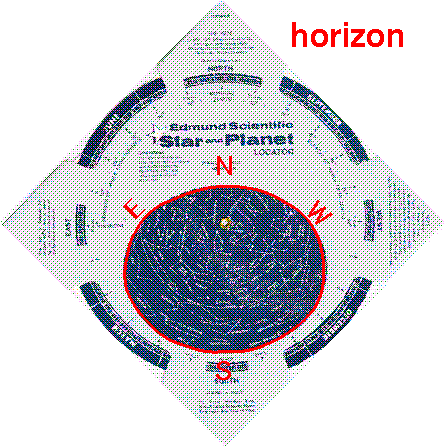

The horizon is where the sky meets the ground. The horizon we actually see is a jagged line, as buildings, trees, and hills interrupt our view of the stars behind them. On the star finder the horizon is the window in the holder through which the star map is seen. The dome of the stars (i.e., the stars we see at a particular time) is displayed inside the window. Ideally (out in the middle of a flat field in Kansas) the horizon is a 360° circle. Looking north you could turn 360° clockwise: crossing first due east, then due south, then west and finally back to due north. On maps we're used to seeing those directions (NESW) displayed with north up and east to the right. Note that the star finder does not work that way. The north and south points of the horizon are on opposite side of the window, but west is to the right if north is up. This reversal of east and west is a result of a change in perspective. Maps of the Earth display "God's view": looking down from the heavens. Maps of the heavens display "man's view": looking up from the Earth. Think about holding the star finder over your head while facing north. Aligning the north point of the star finder's horizon with the north point of the actual horizon. The star finder now correctly shows that east is to the right and west is to the left.
Additionally, the due west point on the star finder is not at the end of the oval window; instead it's nearly half-way to the north point. East is not opposite to west: it's towards the left, but again as near to the north point as to the end of the oval. This distortion of the cardinal directions is a result of the distortion of the star map (which gets quite distorted near its edge).